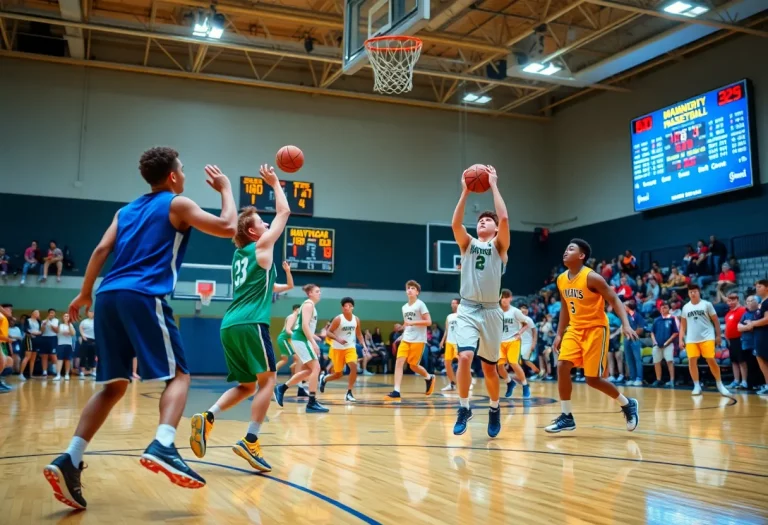News Summary
The Pennsylvania Interscholastic Athletic Association (PIAA) has decided against implementing a shot clock for high school basketball, continuing the tradition of play without timed limits. Supporters argue it would enhance game dynamics, while opponents cite budget concerns and the potential for altered strategies. Mixed reactions from schools reflect ongoing debates about the future of sports in Pennsylvania, as other states move towards adopting similar rules.
PIAA Decides Against Shot Clock for High School Basketball
In a recent meeting held by the Pennsylvania Interscholastic Athletic Association (PIAA), it was announced that the much-debated shot clock proposal for high school basketball has been voted down by the steering committee. This decision means that **students will continue to play without a shot clock in their schools** until at least the 2025-26 season.
The idea of implementing a shot clock in Pennsylvania high school gyms has been a topic of discussion for several years. Advocates believe it would lead to **higher scoring games and a more dynamic offense**, while others are concerned about its impact on game strategy. The decision to maintain the current system does not seem to have dulled the enthusiasm of advocates who see the shot clock as a necessary advancement to keep up with the evolving game.
Among those advocating for the shot clock is Butler girls coach Mark Maier, who has passionately expressed his belief in its benefits. He highlights that currently, teams holding a lead late in the game often choose to run down the clock instead of actively trying to score, which sometimes leaves fans feeling that the game lacks excitement. This lapse into a “stall” strategy might be functional, but it often turns games into a rather dull affair for spectators.
The subject was put in motion after the National Federation of State High School Associations (NFHS) voted in 2021 to allow individual state associations the choice to adopt a shot clock. Surprisingly, by spring 2025, **31 states and Washington, D.C.** will have embraced this rule, while Pennsylvania remains on the sidelines.
A survey conducted by the PIAA revealed mixed feelings about the shot clock among its member schools. Interestingly, **55% of the schools in attendance voiced their approval**, while a notable 30% chose not to respond. Butler’s athletic director, Bill Mylan, sought valuable feedback from coaches like Maier and his counterpart Matt Clement regarding this topic.
Moreover, Maier not only proposed the shot clock but also pushed for changes in playoff eligibility, suggesting **every team should get a shot at the playoffs**, along with a more flexible timeout structure— switching from two 30-second timeouts per half to four 60-second timeouts. This ambitious vision clearly aims to foster inclusivity and excitement in the competition.
However, the **cost of implementing a shot clock** is a significant concern. Estimates range from $5,000 to $20,000 depending on the type and model selected, which some schools find prohibitive given their current budget constraints. There’s also the necessity for personnel to manage the shot clock during games, further complicating the decision.
Throughout this debate, it has become clear that opinions among coaches are split. Some view the shot clock’s introduction as a potential game-changer that could elevate the entertainment value, while others believe it may not significantly modify how games are played. For instance, coaches like Charlie Fisher from Manheim Central argue that while the shot clock may not drastically change gameplay, it would likely still enrich the overall experience for fans and players alike.
In a previous PIAA survey taken in 2022, support for the shot clock was nearly evenly divided, showing 49.2% in favor and 50.8% against. This fluctuation in opinions undoubtedly adds complexity to future discussions about the proposal. PIAA’s executive director, Bob Lombardi, anticipated this, mentioning that survey results contribute to the overall dialogue but are not definitive in shaping future decisions.
As it stands, conversations surrounding the shot clock in Pennsylvania high school basketball will continue to bloom. The **NCAA operates with a 30-second shot clock**, while professional leagues such as the NBA and WNBA have their own variations at 24 seconds. Coaches all around Pennsylvania emphasize the importance of quicker decision-making, believing a shot clock could eventually lead to a more exhilarating and engaging game.
Deeper Dive: News & Info About This Topic
LIVE BALL Resources
New Rules Coming to High School Basketball in Colorado
Discussions on High School Basketball Shot Clocks in Pennsylvania
Additional Resources
- Butler Eagle
- Wikipedia: Shot Clock
- On3
- Google Search: PIAA shot clock high school basketball
- TribLive
- Encyclopedia Britannica: Shot Clock
- Sun Gazette
- Google News: PIAA shot clock
- Post Gazette
- Google Scholar: PIAA shot clock high school basketball


